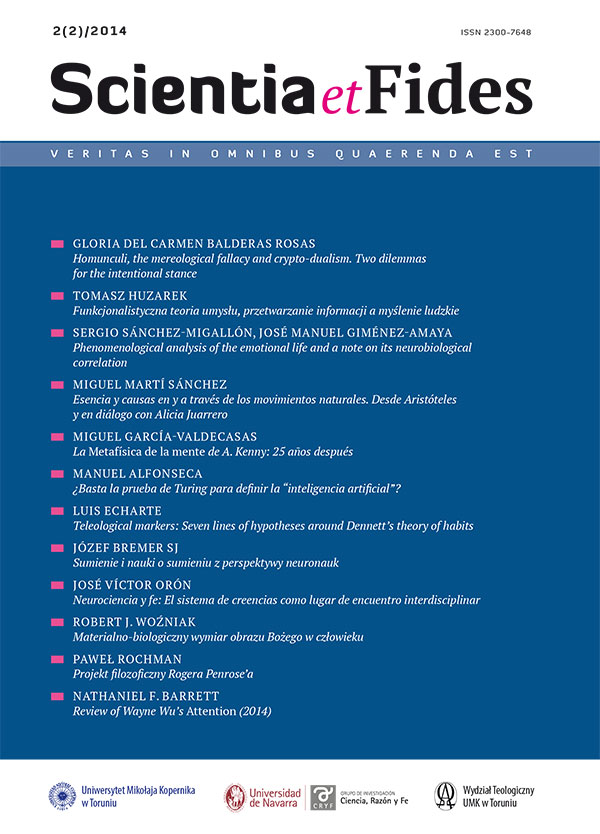Sumienie i nauki o sumieniu z perspektywy neuronauk
DOI:
https://doi.org/10.12775/SetF.2014.020Parole chiave
sumienie, sądy moralne, neuroobrazowanie, neuronauki, emocje, deontologia, konsekwencjonalizmAbstract
W ostatnich latach obserwujemy wzrost empirycznych badań nad biologicznymi korelatami sumienia i podejmowania decyzji moralnych. Centralne pytania zadawane w tych neuronaukowych badaniach dotyczą: a) roli emocji w decyzjach sumienia, b) określenia regionów mózgu skorelowanych z tymi decyzjami. Odpowiadając na nie, omówię najpierw podstawową terminologię oraz przedstawię neuroetyczne analizy P. Churchland, a także wyniki badań empirycznych, przeprowadzonych przez J. Greene’a, A. Damasio i innych. Następnie poddam krytycznej ocenie tezę Greene’a, odmawiającą deontologii statusu teorii moralnej oraz odpowiem na pytanie, czy na podstawie badań empirycznych możemy wnioskować o słuszności jakiejś teorii moralnej (deontologicznej bądź konsekwencjonalistycznej).Riferimenti bibliografici
Biesaga, T. 2004. „Konsekwencjonalizm.” W Powszechna encyklopedia filozoficzna. Lublin: KUL, Polskie Towarzystwo Tomasza z Akwinu, t. 5: 801-803.
Blackburna, S. 1993. How To Be an Ethical Anti-Realist. Essays in Quasi-Realism. New York: Oxford University Press.
Bremer, J. 2013. „Czym jest neuromarketing?” Communication Today 1/4: 18-34.
Bremer, J. 2013. Czy wolna wola jest wolna? Kompatybilizm na tle badań interdyscyplinarnych. Kraków: WAM.
Bremer, J. 2005. Jak to jest być świadomym. Analityczne teorie umysłu a problem świadomości. Warszawa: IFiS PAN.
Bremer, J. 2010. Wprowadzenie do filozofii umysłu. Kraków: WAM.
Brians, P. 2013. Common Errors in English Usage, Portland/OR: William, James & Company.
Churchland, P. 2013. Moralność mózgu. Co neuronauka mówi o moralności. Kraków: Copernicus Center Press. Przekład: M. Hohol. [oryg.: 2011. Braintrust: What Neuroscience Tells Us about Morality. Princeton: Princeton UP.].
Damasio, A.R. 2011. Błąd Kartezjusza. Emocje, rozum i ludzki mózg. Poznań: Rebis. Przekład: M. Karpiński.
Dennetta, D. 1993. La conscience expliquée. Paris: Odile Jacob.
Dewey, J. 1906. ”The Terms 'Conscious' and 'Consciousness'.” Journal of Philosophy, Psychology and Scientific Method 3: 39-41. DOI: http://dx.doi.org/10.2307/2011714.
Duch, W. 2008/2009. „Emocje i układ limbiczny.” http://www.fizyka.umk.pl/~duch/Wyklady/Mozg/07-3-limbiczny.htm, dostęp: 26.07.14.
Duus, P. 1989. Diagnostyka topograficzna w neurologii. Warszawa: Państwowy Zakład Wydawnictw Lekarskich.
Greene, J. 2007. “The Secret Joke of Kant’s Soul.” W W. Sinnott-Armstrong (red.), Moral Psychology, t. 3: The Neuroscience of Morality: Emotion, Brain Disorders, and Development, Cambridge/MA, and London: MIT Press, 35-79.
Hallgarth, M.W. 1996. „Consequentialism and Deontology.” W R. Chadwicks (red.), Encyclopedia of Applied Ethics. San Diego: Academic Press, t. 1: 609-621.
Hanson, J.L., Chung, M.K., Avants, B.B., Shirtcliff, E.A., Gee, J.C., Davidson, R.J., Pollak, S.D. 2010. “Early Stress Is Associated with Alterations in the Orbitofrontal Cortex: A Tensor-Based Morphometry Investigation of Brain Structure and Behavioral Risk.” The Journal of Neuroscience 22/30.
Hoffman, M.B. 2014. The Punisher’s Brain. N. York: Cambridge University Press.
Hume, D. 1963. Traktat o naturze ludzkiej. Warszawa: PWN. Przekład: Cz. Znamierowski.
Kant, I. 1984. Krytyka praktycznego rozumu. Warszawa: PWN. Przekład: J. Gałecki.
Kant, I. 2005. Metafizyka moralności. Warszawa: WN PWN. Przekład: E. Nowak.
Koenigs, M., Young, L., Adolphs, R., Tranel, D., Cushman, F., Hauser, M., Damasio, A. 2007. “Damage to the Prefrontal Cortex Increases Utilitarian Moral Judgments.” Nature 446: 908-911.
Kranich-Strötz, Ch. 2008. Selbstbewusstsein und Gewissen: Zur Rekonstruktion der Individualitätskonzeption bei Peter Abaelard - Subjekt, Zeit, Geschichte. Berlin: LIT-Verlag, t. 2.
Kringelbach, M.L., Rolls, E.T. 2004. “The Functional Neuroanatomy of the Human Orbitofrontal Cortex: Evidence from Neuroimaging and Neuropsychology.” Progress in Neurobiology 72: 341–372.
Neubertemail, F.-X., Mars, R.B., Thomas, A.G., Sallet, J., Rushworth, M.F.S. 2014. “Comparison of Human Ventral Frontal Cortex Areas for Cognitive Control and Language with Areas in Monkey Frontal Cortex.” Neuron 3/81: 700–713.
Nunner-Winkler, G. 2006. “Freiwillige Selbstbindung aus Einsicht - ein moderner Modus moralischer Motivation.” W H.F. Klemme, M. Kühn, D. Schönecker (red.), Moralische Motivation: Kant und die Alternativen. Hamburg: Felix Meiner, 165-192.
Raab, G., Gernsheimer, O., Schindler, M. 2009. Neuromarketing: Grundlagen – Erkenntnisse – Anwendungen. Wiesbaden: Gabler Verlager.
Singer, T., Seymour, B., O’Doherty, J., Kaube, H., Dolan, R.J., Frith, Ch.D. 2004. “Empathy for Pain Involves the Affective but not Sensory Components of Pain.” Science 303: 1157-1162. DOI: http://dx.doi.org/10.1126/science.1093535.
Stach, R., Popek, A.M. 2013. „Decyzje ekonomiczne i społeczne z perspektywy pogranicza neuronauk oraz nauk o zarządzaniu.” International Journal of Contemporary Management 2/13: 48–57.
Tomasz z Akwinu. 1952. Summa Theologiae. Romae: Marietti.
Urbańczyk, S. (red.). 1977-1981. Słownik staropolski. Wrocław: Ossolineum, t. 8: 505-506.
Wayne, M. 2006. Conscience and Consciousness: Rousseau's Critique of the Stoic Theory of Oikeosis. http://philosophy.fas.nyu.edu/object/philo.courses.ml06.html, dostęp: 24.05.14.
Downloads
Pubblicato
Come citare
Fascicolo
Sezione
Licenza
Copyright (c) 2014 Scientia et Fides

Questo lavoro è fornito con la licenza Creative Commons Attribuzione - Non opere derivate 4.0 Internazionale.
CC BY ND 4.0. The Creator/Contributor is the Licensor, who grants the Licensee a non-exclusive license to use the Work on the fields indicated in the License Agreement.
- The Licensor grants the Licensee a non-exclusive license to use the Work/related rights item specified in § 1 within the following fields: a) recording of Work/related rights item; b) reproduction (multiplication) of Work/related rights item in print and digital technology (e-book, audiobook); c) placing the copies of the multiplied Work/related rights item on the market; d) entering the Work/related rights item to computer memory; e) distribution of the work in electronic version in the open access form on the basis of Creative Commons license (CC BY-ND 3.0) via the digital platform of the Nicolaus Copernicus University Press and file repository of the Nicolaus Copernicus University.
- Usage of the recorded Work by the Licensee within the above fields is not restricted by time, numbers or territory.
- The Licensor grants the license for the Work/related rights item to the Licensee free of charge and for an unspecified period of time.
FULL TEXT License Agreement
Stats
Number of views and downloads: 739
Number of citations: 0



